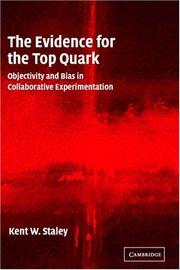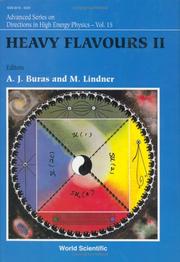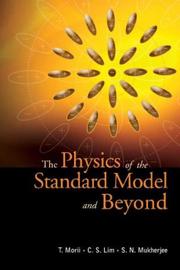| Listing 1 - 10 of 13 | << page >> |
Sort by
|

ISBN: 0521827108 Year: 2004 Publisher: Cambridge Cambridge University press
Abstract | Keywords | Export | Availability | Bookmark
 Loading...
Loading...Choose an application
- Reference Manager
- EndNote
- RefWorks (Direct export to RefWorks)
Particles (Nuclear physics) --- Quarks. --- Flavor. --- Quarks --- Flavor (Nuclear physics) --- Flavor models (Nuclear physics) --- Top quark models --- Truth models (Nuclear physics) --- Flavor --- Partons --- Quark-gluon interactions
Book
ISBN: 1322063613 9814503584 9789814503587 9810208219 9810208227 9789810208219 9789810208226 Year: 1992 Volume: 10 Publisher: Singapore
Abstract | Keywords | Export | Availability | Bookmark
 Loading...
Loading...Choose an application
- Reference Manager
- EndNote
- RefWorks (Direct export to RefWorks)
This volume is a collection of review articles on the most outstanding topics in heavy flavour physics. All the authors have made significant contributions to this field. The book reviews in detail the theoretical structure of heavy flavour physics within the Standard Model and its confrontation with existing experimental data. The physics of the top quark and of the Higgs play an important role in this volume. Beginning with radiative electroweak corrections and their impressive tests at LEP and hadron colliders, the book summarizes the present status of quark mixing, CP violation and rare de
Particles (Nuclear physics) --- Quantum flavor dynamics. --- Dynamics, Quantum flavor --- Flavor dynamics, Quantum --- Quantum theory --- Quarks --- Flavor (Nuclear physics) --- Flavor models (Nuclear physics) --- Top quark models --- Truth models (Nuclear physics) --- Flavor. --- Particules (Physique nucléaire) --- Flavor --- Saveur --- Heavy particles (Nuclear physics)

ISBN: 9812812660 9789812812667 9810222157 9789810222154 Year: 1998 Volume: vol. 15 Publisher: Singapore River Edge, N.J. World Scientific
Abstract | Keywords | Export | Availability | Bookmark
 Loading...
Loading...Choose an application
- Reference Manager
- EndNote
- RefWorks (Direct export to RefWorks)
This volume is a collection of review articles on the most outstanding topics in heavy flavour physics. All the authors have made significant contributions to this field. The book reviews in detail the theoretical structure of heavy flavour physics and confronts the Standard Model and some of its extensions with existing experimental data.This new edition covers new trends and ideas and includes the latest experimental information. Compared to the previous edition interesting new activities are included and some of the key contributions are updated. Particular attention is paid to the discover
Particles (Nuclear physics) --- Quantum flavor dynamics. --- Quarks. --- Partons --- Quark-gluon interactions --- Dynamics, Quantum flavor --- Flavor dynamics, Quantum --- Quantum theory --- Quarks --- Flavor (Nuclear physics) --- Flavor models (Nuclear physics) --- Top quark models --- Truth models (Nuclear physics) --- Flavor. --- Quantum flavor dynamics --- Particules (Physique nucléaire) --- Saveur
Book
ISBN: 3030191974 3030191966 Year: 2019 Publisher: Cham : Springer International Publishing : Imprint: Springer,
Abstract | Keywords | Export | Availability | Bookmark
 Loading...
Loading...Choose an application
- Reference Manager
- EndNote
- RefWorks (Direct export to RefWorks)
This PhD thesis is dedicated to a subfield of elementary particle physics called “Flavour Physics”. The Standard Model of Particle Physics (SM) has been confirmed by thousands of experimental measurements with a high precision. But the SM leaves important questions open, like what is the nature of dark matter or what is the origin of the matter-antimatter asymmetry in the Universe. By comparing high precision Standard Model calculations with extremely precise measurements, one can find the first glimpses of the physics beyond the SM – currently we see the first hints of a potential breakdown of the SM in flavour observables. This can then be compared with purely theoretical considerations about new physics models, known as model building. Both precision calculations and model building are extremely specialised fields and this outstanding thesis contributes significantly to both topics within the field of Flavour Physics and sheds new light on the observed anomalies.
Particles (Nuclear physics) --- Flavor. --- Flavor (Nuclear physics) --- Flavor models (Nuclear physics) --- Top quark models --- Truth models (Nuclear physics) --- Quarks --- Quantum theory. --- Elementary Particles, Quantum Field Theory. --- Theoretical, Mathematical and Computational Physics. --- Quantum dynamics --- Quantum mechanics --- Quantum physics --- Physics --- Mechanics --- Thermodynamics --- Elementary particles (Physics). --- Quantum field theory. --- Mathematical physics. --- Physical mathematics --- Relativistic quantum field theory --- Field theory (Physics) --- Quantum theory --- Relativity (Physics) --- Elementary particles (Physics) --- High energy physics --- Nuclear particles --- Nucleons --- Nuclear physics --- Mathematics
Book
ISBN: 3030259889 3030259870 Year: 2019 Publisher: Cham : Springer International Publishing : Imprint: Springer,
Abstract | Keywords | Export | Availability | Bookmark
 Loading...
Loading...Choose an application
- Reference Manager
- EndNote
- RefWorks (Direct export to RefWorks)
Astrophysical observations implying the existence of Dark Matter and Dark Energy, which are not described by the Standard Model (SM) of particle physics, have led to extensions of the SM predicting new particles that could be directly produced at the Large Hadron Collider (LHC) at CERN. Based on 2015 and 2016 ATLAS proton-proton collision data, this thesis presents searches for the supersymmetric partner of the top quark, for Dark Matter, and for DarkEnergy, in signatures with jets and missing transverse energy. Muon detection is key to some of the most important LHC physics results, including the discovery of the Higgs boson and the measurement of its properties. The efficiency with which muons can be detected with the ATLAS detector is measured using Z boson decays. The performance of high-precision Monitored Drift Tube muon chambers under background rates similar to the ones expected for the High Luminosity-LHC is studied.
Quantum theory. --- Elementary Particles, Quantum Field Theory. --- Cosmology. --- Theoretical, Mathematical and Computational Physics. --- Quantum dynamics --- Quantum mechanics --- Quantum physics --- Physics --- Mechanics --- Thermodynamics --- Particles (Nuclear physics) --- Flavor. --- Flavor (Nuclear physics) --- Flavor models (Nuclear physics) --- Top quark models --- Truth models (Nuclear physics) --- Quarks --- Elementary particles (Physics). --- Quantum field theory. --- Mathematical physics. --- Physical mathematics --- Astronomy --- Deism --- Metaphysics --- Relativistic quantum field theory --- Field theory (Physics) --- Quantum theory --- Relativity (Physics) --- Elementary particles (Physics) --- High energy physics --- Nuclear particles --- Nucleons --- Nuclear physics --- Mathematics
Book
ISBN: 9811509328 981150931X Year: 2019 Publisher: Singapore : Springer Singapore : Imprint: Springer,
Abstract | Keywords | Export | Availability | Bookmark
 Loading...
Loading...Choose an application
- Reference Manager
- EndNote
- RefWorks (Direct export to RefWorks)
This book reports on the search for a new heavy particle, the Vector-Like Top quark (VLT), in the Large Hadron Collider (LHC) at CERN. The signal process is the pair production of VLT decaying into a Higgs boson and top quark (TT→Ht+X, X=Ht, Wb, Zt). The signal events result in top–antitop quarks final states with additional heavy flavour jets. The book summarises the analysis of the data collected with the ATLAS detector in 2015 and 2016. In order to better differentiate between signals and backgrounds, exclusive taggers of top quark and Higgs boson were developed and optimised for VLT signals. These efforts improved the sensitivity by roughly 30%, compared to the previous analysis. The analysis outcomes yield the strongest constraints on parameter space in various BSM theoretical models. In addition, the book addresses detector operation and the evaluation of tracking performance. These efforts are essential to properly collecting dense events and improving the accuracy of the reconstructed objects that are used for particle identification. As such, they represent a valuable contribution to data analysis in extremely dense environments.
Particles (Nuclear physics) --- Flavor. --- Flavor (Nuclear physics) --- Flavor models (Nuclear physics) --- Top quark models --- Truth models (Nuclear physics) --- Quarks --- Particle acceleration. --- Nuclear physics. --- Heavy ions. --- Elementary particles (Physics). --- Quantum field theory. --- Particle Acceleration and Detection, Beam Physics. --- Nuclear Physics, Heavy Ions, Hadrons. --- Elementary Particles, Quantum Field Theory. --- Relativistic quantum field theory --- Field theory (Physics) --- Quantum theory --- Relativity (Physics) --- Elementary particles (Physics) --- High energy physics --- Nuclear particles --- Nucleons --- Nuclear physics --- Ions --- Atomic nuclei --- Atoms, Nuclei of --- Nucleus of the atom --- Physics --- Acceleration (Mechanics) --- Acceleration

ISBN: 1281935956 9786611935955 981279560X 9789812795601 9781281935953 9810245718 9789810245719 Year: 2004 Publisher: New Jersey World Scientific
Abstract | Keywords | Export | Availability | Bookmark
 Loading...
Loading...Choose an application
- Reference Manager
- EndNote
- RefWorks (Direct export to RefWorks)
This book provides a unified description of elementary particle interactions and the underlying theories, namely the Standard Model and beyond. The authors have aimed at a concise presentation but have taken care that all the basic concepts are clearly described. Written primarily for graduate students in theoretical and experimental particle physics, The Physics of the Standard Model and Beyond conveys the excitement of particle physics, centering upon experimental observations (new and old) and a variety of ideas for their interpretation.
Contents:
- Weak Interaction<
Standard model (Nuclear physics) --- Nuclear structure. --- Electroweak interactions. --- Neutrinos --- Supersymmetry. --- Particles (Nuclear physics) --- Flavor (Nuclear physics) --- Flavor models (Nuclear physics) --- Top quark models --- Truth models (Nuclear physics) --- Quarks --- Unified theories --- Symmetry (Physics) --- Neutrino mass --- Atomic mass --- Interactions, Electroweak --- Electromagnetic interactions --- Grand unified theories (Nuclear physics) --- Weak interactions (Nuclear physics) --- Structure, Nuclear --- Nuclear physics --- Nuclear models --- Nuclear reactions --- Mass. --- Flavor. --- Modèle standard (Physique nucléaire) --- Structure nucléaire
Book
ISBN: 4431546162 4431546154 Year: 2014 Publisher: Tokyo : Springer Japan : Imprint: Springer,
Abstract | Keywords | Export | Availability | Bookmark
 Loading...
Loading...Choose an application
- Reference Manager
- EndNote
- RefWorks (Direct export to RefWorks)
In this thesis, the measurement of double-spin asymmetry for electron production from heavy flavor decays was performed in a Relativistic Heavy Ion Collider (RHIC) in the PHENIX experiment at Brookhaven National Laboratory to measure the polarized parton distribution function of gluon in the small Bjorken x region (x~0.01). For this experiment, for the first time a Hadron Blind Detector (HBD), which is a position-sensitive gas Cherenkov counter with Gas Electron Multiplier whose surface is evaporated by CsI, was employed. This HBD contributes to reducing the background from electron pairs produced by real and virtual photon conversion. Furthermore, the author develops a new analysis method for the background reduction, and the signal-to-background ratio is improved by a factor of roughly 2.0. Using the combination of the HBD and a new analysis method, the double-spin asymmetry of the electron production with transverse momentum ranging 0.5 < pT < 3.0 GeV/c is measured and confirmed to be zero-consistent within the limit of the statistical uncertainty of about 1%. This result identifies the constraint of the gluon polarization in the small Bjorken x region, a worldwide first.
Particles (Nuclear physics) --- Heavy particles (Nuclear physics) --- Symmetry (Physics) --- Flavor. --- Invariance principles (Physics) --- Symmetry (Chemistry) --- Conservation laws (Physics) --- Physics --- Flavor (Nuclear physics) --- Flavor models (Nuclear physics) --- Top quark models --- Truth models (Nuclear physics) --- Quarks --- Nuclear physics. --- Particle acceleration. --- Nuclear Physics, Heavy Ions, Hadrons. --- Particle Acceleration and Detection, Beam Physics. --- Measurement Science and Instrumentation. --- Acceleration (Mechanics) --- Nuclear physics --- Atomic nuclei --- Atoms, Nuclei of --- Nucleus of the atom --- Acceleration --- Heavy ions. --- Physical measurements. --- Measurement . --- Measuring --- Mensuration --- Mathematics --- Technology --- Metrology --- Physical measurements --- Measurements, Physical --- Mathematical physics --- Measurement --- Ions
Book
ISBN: 1441977988 9786613088314 1441977996 1283088312 Year: 2011 Publisher: New York : Springer,
Abstract | Keywords | Export | Availability | Bookmark
 Loading...
Loading...Choose an application
- Reference Manager
- EndNote
- RefWorks (Direct export to RefWorks)
This original, outstanding thesis presents the first discovery of single top quark production and documents one of the flagship measurements of the D0 experiment, a collaboration of more than 600 particle physicists from around the world. It describes the first observation of a physical process known as “single top quark production,” which had been sought for more than 10 years before its eventual discovery in 2009. This thesis describes, in detail, an innovative approach of using Boosted Decision Trees, a machine-learning technique, to observe the tiny single top signal within an otherwise overwhelming background. The final result was published in August 2009 in Physical Review Letters, the most prestigious journal in the field of experimental particle physics. It was further made an “editor’s choice” in that publication and was highlighted in the journal Physics as one of the most interesting and significant results published in all of physics at that time.
Particles (Nuclear physics). --- Quantum field theory. --- Quarks --- Particles (Nuclear physics) --- Physics --- Physical Sciences & Mathematics --- Electricity & Magnetism --- Nuclear Physics --- Flavor --- Quarks. --- Flavor. --- Flavor (Nuclear physics) --- Flavor models (Nuclear physics) --- Top quark models --- Truth models (Nuclear physics) --- Physics. --- Nuclear physics. --- Heavy ions. --- Hadrons. --- Elementary particles (Physics). --- Nuclear Physics, Heavy Ions, Hadrons. --- Elementary Particles, Quantum Field Theory. --- Partons --- Quark-gluon interactions --- Quantum theory. --- Quantum dynamics --- Quantum mechanics --- Quantum physics --- Mechanics --- Thermodynamics --- Atomic nuclei --- Atoms, Nuclei of --- Nucleus of the atom --- Relativistic quantum field theory --- Field theory (Physics) --- Quantum theory --- Relativity (Physics) --- Elementary particles (Physics) --- High energy physics --- Nuclear particles --- Nucleons --- Nuclear physics --- Ions
Book
ISBN: 3662586290 3662586274 Year: 2019 Publisher: Berlin, Heidelberg : Springer Berlin Heidelberg : Imprint: Springer,
Abstract | Keywords | Export | Availability | Bookmark
 Loading...
Loading...Choose an application
- Reference Manager
- EndNote
- RefWorks (Direct export to RefWorks)
The second edition of this monograph discusses the usefulness of heavy flavor as a probe of TeV-scale physics, exploring a number of recently-uncovered “flavor anomalies” that are suggestive of possible TeV-scale phenomena. The large human endeavor at the Large Hadron Collider has not turned up any New Physics, except the last particle of the Standard Model, the Higgs boson. Revised and updated throughout, this book puts the first results from the LHC into perspective and provides an outlook for a new era of flavor physics. The author readdresses many questions raised in the first edition and poses new ones. As before, the experimental perspective is taken, with a focus on processes, rather than theories or models, as a basis for exploration, and two-thirds of the book is concerned with b -^ s or bs sb transitions. In the face of the advent of Belle II and other flavor experiments, this book becomes a part of a dialogue between the energy/collider and intensity/flavor frontiers that will continue over the coming decade. Researchers with an interest in modern particle physics will find this book particularly valuable.
Quantum theory. --- Elementary Particles, Quantum Field Theory. --- Quantum dynamics --- Quantum mechanics --- Quantum physics --- Physics --- Mechanics --- Thermodynamics --- Particles (Nuclear physics) --- Quantum flavor dynamics. --- B mesons. --- CP violation (Nuclear physics) --- Flavor. --- Charge conjugation parity violation --- Violation, Charge conjugation parity --- Symmetry (Physics) --- Beauty mesons --- Bottom mesons --- Mesons --- Dynamics, Quantum flavor --- Flavor dynamics, Quantum --- Quantum theory --- Quarks --- Flavor (Nuclear physics) --- Flavor models (Nuclear physics) --- Top quark models --- Truth models (Nuclear physics) --- Elementary particles (Physics). --- Quantum field theory. --- Relativistic quantum field theory --- Field theory (Physics) --- Relativity (Physics) --- Elementary particles (Physics) --- High energy physics --- Nuclear particles --- Nucleons --- Nuclear physics
| Listing 1 - 10 of 13 | << page >> |
Sort by
|

 Search
Search Feedback
Feedback About UniCat
About UniCat  Help
Help News
News